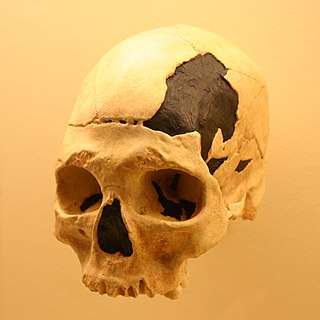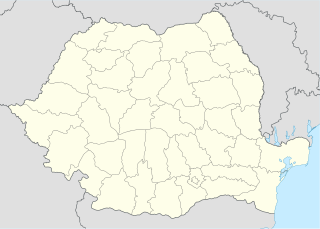Peştera cu oasis
| Peştera cu oasis
|
||
|---|---|---|
|
The fossil oasis 2 |
||
| Location: | Anina , Caraș-Severin County , Romania | |
|
Geographic location: |
45 ° 1 ′ 0 ″ N , 21 ° 50 ′ 0 ″ E | |
|
|
||
| Type: | Karst cave | |
| Discovery: | 2002 | |
| Particularities: | Location of the oldest remains of modern man in Europe | |
Peştera cu oasis ( German bone cave ) is the name of a system of twelve karst caves , which are located in the historical region of Banat , in the Caraş-Severin district , in southwest Romania . There, the oldest remains of anatomically modern humans ( Homo sapiens ) in Europe (40,500 years old) were discovered.
A DNA analysis of the lower jaw Oase 1 showed that the young man from whom this jaw originated was the descendant of a hybrid of Neanderthals and Homo sapiens : 6 to 8 percent of his genome was interpreted as originating from Neanderthals.
Paleoanthropological and Genetic Findings
In February 2002, speleologists who explored the karst system in the Miniș Valley in the southwestern Carpathian Mountains near Anina , in the Anina Mountains , discovered a previously unknown chamber with numerous mammalian skeletons. The cave seems to have mainly been used for wintering by Young Pleistocene cave bears ( Ursus spelaeus ) . The unusual arrangement of some of the bones, for example on elevated rocks, suggested a human influence.
The cave explorers Ștefan Milota, Adrian Bîlgăr and Laurențiu Sarcina found a complete human lower jaw . They called the karst cave Peştera cu oasis and the human lower jaw oasis 1 . Two laboratories independently determined the radiocarbon age at around 35,000 years, which corresponds to a period of 41,770 to 37,310 years in calibrated calendar years (cal BP) for the lower jaw. The fossil is one of the few finds in Europe that could be directly dated and is considered one of the oldest known fossils of an anatomically modern human in Europe. Since the site is near the Iron Gate in the Danube Corridor, the fossil could represent one of the earliest human populations to colonize Europe.
Some features and the proportions of Oasis 1 place the lower jaw in the kinship of modern, Young Pleistocene people, but it also shows features of the archaic Homo sapiens and the Neanderthal . In fact, in 2015, a DNA analysis revealed that the young man from whom this jaw came was the descendant of a mixed race: 6 to 9 percent of his genome was interpreted as being of Neanderthal man. The chromosome 12 contained even an extremely long, the Neanderthals attributable portion that about half of the base pairs comprised of this chromosome. From this it was deduced that the pairing could not have been more than four to six generations ago, since otherwise - due to crossing-over - changes in the base pair sequence would have occurred. However, it has also been proven that the DNA segments from anatomically modern humans are more similar to fossil finds from Asia and not to later finds from Europe or to humans living today; from this it was deduced that the population to which Oasis 1 belonged represented a “dead end”, the genes of which were not included in today's population of Homo sapiens .
In June 2003 another research group consisting of Ștefan Milota, Ricardo Rodrigo and Mircea Gherase discovered further human remains on the cave floor. It was a complete facial skull together with an almost complete temporal bone and a number of frontal , parietal and occipital bone fragments.
While the lower jaw Oasis 1 comes from a young adult, the facial skull, which is referred to as Oasis 2 , belonged to an approx. 15 year old adolescent. Further analyzes initially suggested that the left temporal bone belonged to a third individual, presumably an adult woman, hence called Oasis 3 . However, later work has shown that the temporal bone belongs to the same skull as the other oasis 2 bones. The lack of other archaeological finds such as charcoal or tools could mean that the human remains were washed into the cave through crevices.
Oasis 2 and Oasis 3 confirm a pattern that was already known from the presumably just as old Oasis 1 lower jaw, a mixture of archaic, early modern and Neanderthal features. The "modern" features include a protruding chin, no bulge above the eye and a rounded skull. However, these features are associated with numerous archaic features of the skull and dentition that place it outside the range of variation of modern humans, such as a large face, a bone crest behind the ear, and large teeth that even increase in size towards the back. Anatomical features, which are interpreted in particular by Erik Trinkaus and João Zilhão as the result of a mating of anatomically modern humans ( Homo sapiens ) and Neanderthals, were also used for the 25,000-year-old child from Lagar Velho ( Portugal ) and the 31,000-year-old fossil finds from Mladeč (Czech Republic) asserted.
Research continues in Peştera cu oasis . The findings from the 2005 campaign are currently being investigated at the Romanian cave research institute "Emil Racovita", furthermore at the Australian National University ( electron spin resonance and uranium-thorium dating of 21 bone and tooth samples and 29 sediment samples), the University of Bristol , (uranium thorium -Dating 22 bone samples), the University of Bergen , (uranium-thorium dating of seven samples), the University of Oxford ( accelerator mass spectrometry radiocarbon dating of eight bone and tooth samples), the Max Planck Society ( isotope analysis and DNA analysis of 37 bone and tooth samples) and the University of Vienna (radiocarbon dating of 25 bone and tooth samples).
Significance for paleoanthropology

The particular importance of the Peştera-cu-oasis finds is the combination of "modern" and archaic (Neanderthal) features, as well as the fact that the fossils could be dated directly. The oasis fossils overlap for a period of around 3000 years with late Neanderthals such as those from Vindija Cave ( Croatia ), which have been dated to around 32,000 radiocarbon years or less, or in Arcy-sur-Cure ( France ) with around 34,000 radiocarbon years. The oasis people may have come into contact with Neanderthals.
Since the genetic results known up to that point could not be ruled out that there had been a gene flow from Neanderthal genetics to modern humans in Europe as well , the Peștera cu oasis finds by Erik Trinkaus and João Zilhão were interpreted accordingly in 2006 that such an admixture actually took place. Accordingly, modern humans would have encountered Neanderthals as soon as they arrived in Europe, mixed and mated with them. In the considerably larger gene pool of modern humans - it was argued - the mitochondrial DNA of the Neanderthals was lost over time.
In May 2015, the preliminary results of the sequencing of the DNA of Oase 1 were presented at a symposium in Cold Spring Harbor , New York . As early as 2013, the same team had calculated using the Siberian thigh bone of Ust-Ishim that the time of the gene flow must have been around 45,000 years ago. In fact, the genetic analysis of Oasis 1 has now shown that this fossil has a share of 5 to 11 percent of DNA fragments from the Neanderthal. On the basis of this study it could be proven that a successful mating of Homo sapiens and Neanderthals took place not only in the Middle East, but also in Europe. Nevertheless, Erik Trinkaus' hybridization thesis would at least be confirmed for this find.
Web links
- Early Europeans mixed up with Neanderthals. On: mpg.de from June 22, 2015, with a picture of the lower jaw Oase 1
Individual evidence
- ↑ a b c d Erik Trinkaus , Ştefan Milotab et al .: Early Modern Human Cranial remains from the Peştera cu Oase, Romania. In: Journal of Human Evolution. Volume 45, No. 3, 2003, pp. 245-253, doi: 10.1016 / j.jhevol.2003.08.003 , full text (PDF; 346 kB).
- ↑ Oxford: OxA-11711, Groningen: GrA-22810
- ↑ a b Erik Trinkaus , Oana Moldovan et al .: An early modern human from the Peștera cu Oase, Romania. In: PNAS . Volume 100, No. 20, 2003, pp. 11231–11236, doi: 10.1073 / pnas.2035108100 , full text (PDF).
- ^ Johannes van der Plicht et al .: Recent developments in calibration for archaeological and environmental samples. In: Radiocarbon. Online publication of April 21, 2020, doi: 10.1017 / RDC.2020.22 .
- ↑ a b c João Zilhão : Neandertals and Moderns Mixed and It Matters. In: Evolutionary Anthropology. Volume 15, No. 5, 2006, ISSN 1060-1538 , pp. 183-195, doi: 10.1002 / evan.20110 .
-
↑ Qiaomei Fu et al .: An early modern human from Romania with a recent Neanderthal ancestor. In: Nature. Volume 524, No. 7564, 2015, pp. 216–219, doi: 10.1038 / nature14558
Ann Gibbons: Ancient DNA pinpoints Paleolithic liaison in Europe. In: Science. Volume 348, No. 6237, 2015, p. 847, doi: 10.1126 / science.348.6237.847 - ↑ Ewen Callaway: Early European may have had Neanderthal great-great-grandparent. On: nature.com from May 13, 2015, full text
- ↑ Erik Trinkaus, João Zilhão et al .: The Peștera cu Oase and early modern humans in Southeastern Europe. In: Nicholas J. Conard (ed.): When Neanderthals and modern humans met. Kerns, Tübingen 2006, ISBN 3-935751-03-6 , pp. 145-164.
- ↑ Andrei Soficaru, Adrian Doboş, Erik Trinkaus: Early modern humans from the Peştera Muierilor, Baia de Fier, Romania. In: PNAS. Volume 103, No. 46, 2006, pp. 17196–17201, doi : 10.1073 / pnas.0608443103 , full text (PDF) .
- ↑ Erik Trinkaus : Early Modern Humans . In: Annual Review of Anthropology . tape 34 , 2005, ISSN 0084-6570 , p. 207-230 , doi : 10.1146 / annurev.anthro.34.030905.154913 .
- ↑ Ewen Callaway: Early European may have had Neanderthal great-great-grandparent. On: nature.com from May 13, 2015, doi : 10.1038 / nature.2015.17534
- ^ Ann Gibbons: Ancient DNA pinpoints Paleolithic liaison in Europe. In: Science. Volume 348, No. 6237, 2015, p. 847, doi: 10.1126 / science.348.6237.847

